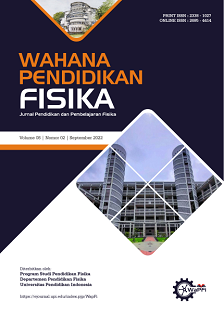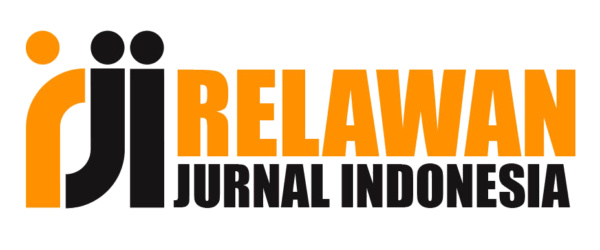SiGMA: A Self-Regulated Learning Strategy for Kinesthetic Learning Styles in Online Education
Abstract
Keywords
Full Text:
PDFReferences
Abidah, A., Hidaayatullaah, H. N., Simamora, R. M., Fehabutar, D., & Mutakinati, L. (2020). The Impact of Covid-19 to Indonesian Education and Its Relation to the Philosophy of “Merdeka Belajar.” Studies in Philosophy of Science and Education, 1(1), 38–49. https://doi.org/10.46627/sipose.v1i1.9
Alvarez, R. P., Jivet, I., Perez-Sanagustin, M., Scheffel, M., & Verbert, K. (2022). Tools Designed to Support Self-Regulated Learning in Online Learning Environments: A Systematic Review. In IEEE Transactions on Learning Technologies (Vol. 15, Issue 4, pp. 508–522). https://doi.org/10.1109/TLT.2022.3193271
Aviyanti, L., Fratiwi, N. J., Gani, A. W., Salam, A., Simbolon, G. H. T., & Purwanto, M. G. (2025). Exploring HOTS on global warming concepts, self-efficacy and learning motivation among high school students. Momentum: Physics Education Journal, 9(2), 217–227. https://doi.org/10.21067/mpej.v9i2.11335
Bali, M. M. E. I., & Musrifah. (2020). The Problems of Application of Online Learning in the Affective and Psychomotor Domains During the Covid-19 Pandemic. Jurnal Pendidikan Agama Islam, 17(2), 137–154. https://doi.org/10.14421/jpai.2020.172-03
Barnard-Brak, L., Lan, W. Y., & Paton, V. O. (2010). Profiles in self-regulated learning in the online learning environment. International Review of Research in Open and Distance Learning, 11(1), 61–80. https://doi.org/10.19173/irrodl.v11i1.769
Bornstein, M. H., & Gardner, H. (1986). Frames of Mind: The Theory of Multiple Intelligences. Journal of Aesthetic Education, 20(2), 120. https://doi.org/10.2307/3332707
Chaturvedi, K., Vishwakarma, D. K., & Singh, N. (2021). COVID-19 and its impact on education, social life and mental health of students: A survey. Children and Youth Services Review, 121. https://doi.org/10.1016/j.childyouth.2020.105866
Dunn, J. R., & Schweitzer, M. E. (2005). Feeling and believing: The influence of emotion on trust. Journal of Personality and Social Psychology, 88(5), 736. https://doi.org/10.1037/0022-3514.88.5.736
Dutta, D. A. (2020). Impact of Digital Social Media on Indian Higher Education: Alternative Approaches of Online Learning during COVID-19 Pandemic Crisis. International Journal of Scientific and Research Publications (IJSRP), 10(05), 604–611. https://doi.org/10.29322/ijsrp.10.05.2020.p10169
Firman, F., & Rahayu, S. (2020). Pembelajaran Online di Tengah Pandemi Covid-19. Indonesian Journal of Educational Science (IJES), 2(2), 81–89. https://doi.org/10.31605/ijes.v2i2.659
Firmansyah, F. (2021). Motivasi Belajar dan Respon Siswa terhadap Online Learning sebagai Strategi Pembelajaran di Masa Pandemi Covid-19. EDUKATIF : JURNAL ILMU PENDIDIKAN, 3(2), 589–597. https://doi.org/10.31004/edukatif.v3i2.355
Irawan, A. W., Dwisona, D., & Lestari, M. (2020). Psychological Impacts of Students on Online Learning During the Pandemic COVID-19. KONSELI : Jurnal Bimbingan Dan Konseling (E-Journal), 7(1), 53–60. https://doi.org/10.24042/kons.v7i1.6389
Klein, P., Ivanjek, L., Dahlkemper, M. N., Jeličić, K., Geyer, M. A., Küchemann, S., & Susac, A. (2021). Studying physics during the COVID-19 pandemic: Student assessments of learning achievement, perceived effectiveness of online recitations, and online laboratories. Physical Review Physics Education Research, 17(1). https://doi.org/10.1103/PhysRevPhysEducRes.17.010117
Kolb, D. (2000). The Process of Experiential Learning. In Strategic Learning in a Knowledge Economy (Issue 1984, pp. 313–331). https://doi.org/10.1016/b978-0-7506-7223-8.50017-4
Kusumaningrum, B., & Wijayanto, Z. (2020). Apakah Pembelajaran Matematika Secara Daring Efektif? (Studi Kasus pada Pembelajaran Selama Masa Pandemi Covid-19). Kreano, Jurnal Matematika Kreatif-Inovatif, 11(2), 136–142. https://doi.org/10.15294/kreano.v11i2.25029
Mamolo, L. A. (2022). Online Learning and Students’ Mathematics Motivation, Self-Efficacy, and Anxiety in the “new Normal.” Education Research International, 2022. https://doi.org/10.1155/2022/9439634
Maqableh, M., & Alia, M. (2021). Evaluation online learning of undergraduate students under lockdown amidst COVID-19 Pandemic: The online learning experience and students’ satisfaction. Children and Youth Services Review, 128. https://doi.org/10.1016/j.childyouth.2021.106160
Novita, D., & Hutasuhut, A. R. (2020). Plus Minus Aplikasi Pembelajaran Daring. Unimed Medan, 10.
Pace, C., Pettit, S., & Barker, K. (2020). Best Practices in Middle Level Quaranteaching: Strategies, Tips and Resources Amidst COVID-19. Becoming: Journal of the Georgia Middle School Association, 31(1). https://doi.org/10.20429/becoming.2020.310102
Pantidos, P., Valakas, K., Vitoratos, E., & Ravanis, K. (2008). Towards applied semiotics: An analysis of iconic gestural signs regarding physics teaching in the light of theatre semiotics. In Semiotica (Vol. 172, pp. 201–231). https://doi.org/10.1515/SEMI.2008.095
Pardede, K., Ahmad, M., & Harahap, M. S. (2021). Analisis Gaya Belajar serta Pengaruh terhadap Hasil Belajar Matematika Siswa Selama Pandemi COVID-19. JURNAL MathEdu (Mathematic Education Journal), 4(2), 243–252. https://doi.org/10.37081/mathedu.v4i2.2526
Rahmawati, D., Hasanah, M., & Amelasasih, P. (2023). Self Regulated Learning pada Mahasiswa yang Bekerja. Al-Ihath: Jurnal Bimbingan Dan Konseling Islam, 3(2), 117–145. https://doi.org/10.53915/jbki.v3i2.338
Reimers, F., Schleicher, A., Saavedra, J., & Tuominen, S. (2020). Supporting the continuation of teaching and learning during the COVID-19 pandemic. Annotated resources for online learning. Oecd, 1–38. https://www.oecd.org/education/Supporting-the-continuation-of-teaching-and-learning-during-the-COVID-19-pandemic.pdf
Scherr, R. E. (2008). Gesture analysis for physics education researchers. In Physical Review Special Topics - Physics Education Research (Vol. 4, Issue 1). https://doi.org/10.1103/PhysRevSTPER.4.010101
Soland, J., Kuhfeld, M., Tarasawa, B., Johnson, A., Ruzek, E., & Wednesday, J. L. (2020). The impact of COVID-19 on student achievement and what it may mean for educators. Brookings Institution, 1–7. https://www.brookings.edu/blog/brown-center-chalkboard/2020/05/27/the-impact-of-covid-19-on-student-achievement-and-what-it-may-mean-for-educators/
Wolters, C. A., & Brady, A. C. (2021). College students’ time management: A self-regulated learning perspective. Educational Psychology Review. https://doi.org/10.1007/s10648-020-09519-z
Yin, H. (2016). Knife-like mouth and tofu-like heart: emotion regulation by Chinese teachers in classroom teaching. Social Psychology of Education, 19, 1–22. https://doi.org/10.1007/s11218-015-9319-5
Zeidner, M., & Stoeger, H. (2019). Self-Regulated Learning (SRL): A guide for the perplexed. High Ability Studies, 30(1–2), 9–51. https://doi.org/10.1080/13598139.2019.1589369
Zimmerman, B. J. (2002). Becoming a self-regulated learner: An overview. In Theory into Practice (Vol. 41, Issue 2, pp. 64–70). https://doi.org/10.1207/s15430421tip4102_2
DOI: https://doi.org/10.17509/wapfi.v10i2.88250
Refbacks
- There are currently no refbacks.
Copyright (c) 2025 WaPFi (Wahana Pendidikan Fisika)

This work is licensed under a Creative Commons Attribution-ShareAlike 4.0 International License.
The Journal Wahana Pendidikan Fisika http://ejournal.upi.edu/index.php/WapFi/ is licensed under a Creative Commons Attribution-ShareAlike 4.0 International License
The Journal WaPFi (Wahana Pendidikan Fisika).
All rights reserverd. pISSN 2338-1027 eISSN 2685-4414
Copyright © Faculty of Mathematics and Science Education (FPMIPA) Universitas Pendidikan Indonesia (UPI)











